Non-fatal injuries 498 | Start date June 25, 1996 Total number of deaths 20 | |
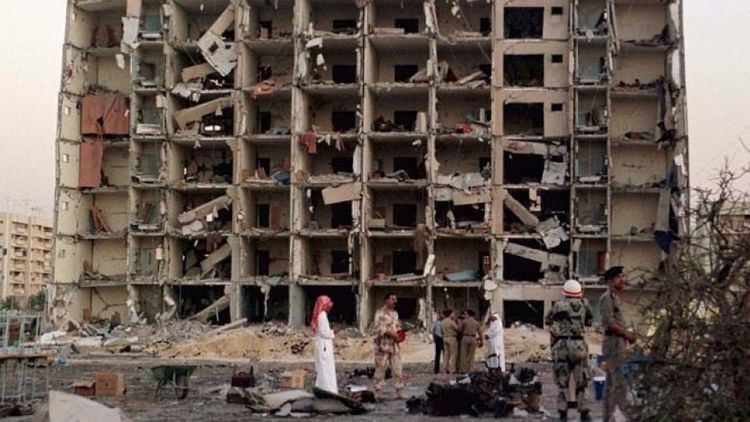 | ||
Attack types Car bomb, Mass murder, State-sponsored terrorism Similar USS Cole bombing, 1983 Beirut barracks bombings, 1993 World Trade Center bo, 1998 United States em, Riyadh compound bombings | ||
Khobar towers bombing the bomb was bigger than expected
The Khobar Towers bombing was a terrorist attack on part of a housing complex in the city of Khobar, Saudi Arabia, located near the national oil company (Saudi Aramco) headquarters of Dhahran and nearby King Abdulaziz Air Base on June 25, 1996. At that time, Khobar Towers was being used as quarters for Coalition forces who were assigned to Operation Southern Watch, a no-fly zone operation in southern Iraq, as part of the Iraqi no-fly zones.
Contents
- Khobar towers bombing the bomb was bigger than expected
- The attack
- Victims
- Investigation
- Intelligence and security failures
- Operational relocation
- Initial blame
- Indictment
- Attribution to al Qaeda
- References
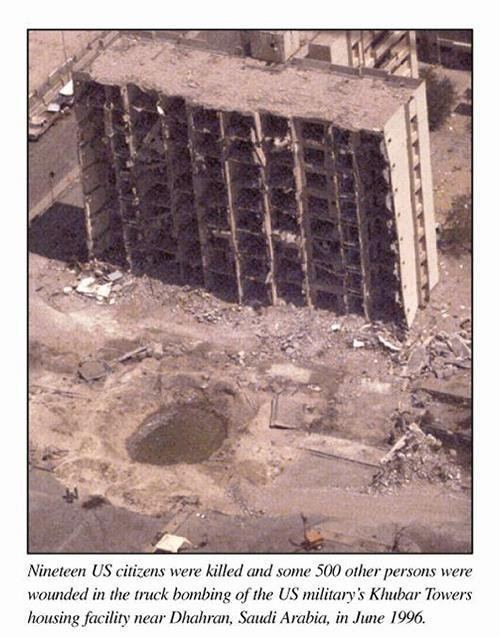
A truck bomb was detonated adjacent to Building #131, an eight-storey structure housing members of the United States Air Force's 4404th Wing (Provisional), primarily from a deployed rescue squadron and deployed fighter squadron. In all, 19 U.S. servicemen and a Saudi local were killed and 498 of many nationalities were wounded. The official June 25, 1996 statement by the United States named members of Hezbollah Al-Hejaz (English: Party of God in the Hijaz) as responsible. In 2006, a U.S. court found Iran and Hezbollah guilty of orchestrating the attack.
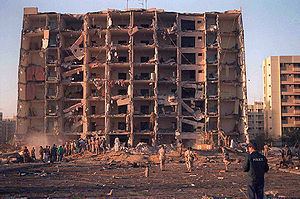
The attack
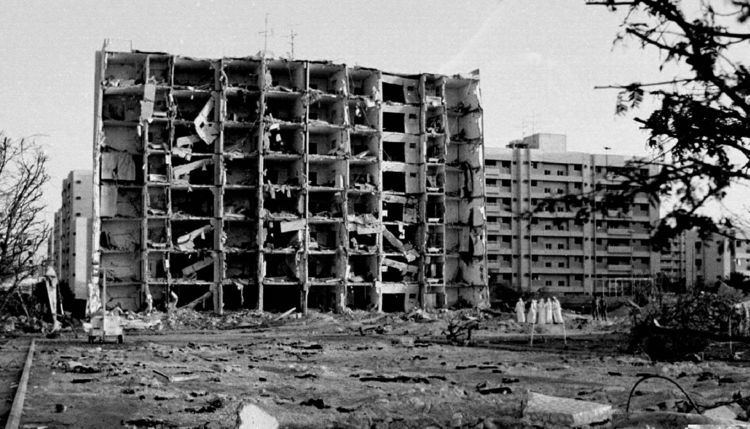
A November 13, 1995 car bombing in Riyadh led the U.S. forces stationed at Khobar Towers to raise the threat condition to THREATCON DELTA. Days after the attack, military commanders briefed soldiers and airmen at Khobar that the U.S. had received anonymous communications from an organization claiming to have carried out the Riyadh attack. The attackers claimed their goal was to get the United States Armed Forces to leave the country, and that Khobar Towers would be attacked next if troop withdrawal did not begin immediately. It was at this time that surveillance and other suspicious activity near the perimeter fences of Khobar Towers was noted by United States Air Force Security Forces; however, the forces were forbidden by the Saudi government to act in any capacity outside the perimeter of the compound, and the surveillance continued with near impunity.
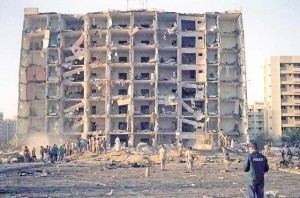
The attackers were reported to have smuggled explosives into Saudi Arabia from Lebanon. Al-Mughassil, Al-Houri, Al-Sayegh, Al-Qassab, and the unidentified Lebanese man bought a large petrol tanker truck in early June 1996 in Saudi Arabia. Over a two-week period they converted it into a truck bomb. The group now had about 5,000 pounds (2,300 kg) of plastic explosives, enough to produce a shaped charge that detonated with the force of at least 20,000 pounds (9,100 kg) of TNT, according to a later assessment of the Defense Special Weapons Agency. The power of the blast was magnified several ways. The truck itself shaped the charge by directing the blast toward the building. Moreover, the relatively high clearance between the truck and the ground gave it the more lethal characteristics of an air burst.
It was originally estimated by U.S. authorities to have contained 3,000 to 5,000 pounds (1,400 to 2,300 kg) of explosives. Later the General Downing report on the incident suggested that the explosion contained the equivalent of 20,000 to 30,000 pounds (9,100 to 13,600 kg) of TNT. The attackers prepared for the attack by hiding large amounts of explosive materials and timing devices in paint cans and 50-kilogram (110 lb) bags underground in Qatif, a city near Khobar. The bomb was a mixture of petrol and explosive powder placed in the tank of a sewage tanker truck.
Initially, the attackers attempted to enter the compound at the main checkpoint. When they were denied access by U.S. military personnel, at around 9:43 p.m. local time, they drove a Datsun scout vehicle, another car and the bomb truck, to a parking lot adjacent to building #131. A chain link security fence and a line of small trees separated the car park, used for a local mosque and park, from the housing compound. The perimeter of Building #131 was approximately 72 feet (22 m) from the fence line, with a perimeter road between the fence and building which was often used by military personnel for jogging. The first car entered the car park and signaled the others by flashing headlights. The bomb truck and a getaway vehicle followed shortly after. The men parked the truck next to the fence and left in the third vehicle. The bomb exploded three to four minutes later at approximately 10:20 p.m. local time. The blast was so powerful that it was felt 20 miles (32 km) away in the Persian Gulf state of Bahrain.
An American sentry, Air Force Staff Sergeant Alfredo R. Guerrero, was stationed atop Building #131. He witnessed the men, recognised the vehicles as a threat, reported it to security, and began a floor by floor evacuation of the building. His actions are credited with saving dozens of lives. Many of the evacuees were in the stairwell when the bomb went off. The stairwell was constructed of heavy marble and was located on the side of the building away from the truck bomb, perhaps the safest location in the building. For his actions, Guerrero was awarded the Airman's Medal, the highest peacetime award for valour that the U.S. Air Force gives.
Another security measure is thought to have minimized damage; along the security fence were Jersey barriers, concrete barriers commonly used along roadways. These deflected the blast energy upward, and away from the lower floors of the building, perhaps even preventing a total collapse of the structure.
The force of the explosion was enormous. The size of the explosion created an intense dust storm as the forces of the high pressure blast wave and the subsequent vacuum forces caused considerable damage in their own right. Several military vehicles parked to the left side of building #131 suffered no direct impact from debris, but were heavily damaged by the sheer intensity of the shock wave.
The explosion heavily damaged or destroyed six high rise apartment buildings in the complex. Windows were shattered in virtually every other building in the compound and in surrounding buildings up to a mile (1.6 km) away. A very large crater, 85 feet (26 m) wide and 35 feet (11 m) deep, was left where the truck had been. Within a few hours of the blast, the crater began to fill with salt-water from the Persian Gulf, which is less than one mile (1.6 km) away. In the minutes following the blast, the residents of the complex evacuated severely injured U.S. military personnel from the area. With power out in many of the buildings near #131, the scene was chaotic and tense as little was known about the safety of the area from further attacks. Many residents later gathered in the local dining facility, set up as a triage centre, and saw breaking news of the event on large projection televisions intended to bring news of events back home to the troops.
Victims
In all, 19 U.S. Air Force personnel were killed:
- Captain Christopher Adams
- Captain Leland Haun
- Master Sergeant Michael G. Heiser
- Master Sergeant Kendall K. Kitson
- Technical Sergeant Daniel B. Cafourek
- Technical Sergeant Patrick P. Fennig
- Technical Sergeant Thanh V. Nguyen
- Staff Sergeant Ronald King
- Staff Sergeant Kevin Johnson
- Sergeant Millard D. Campbell
- Senior Airman Earl R. Cartrette Jr
- Senior Airman Jeremy A. Taylor
- Airman 1st Class Christopher Lester
- Airman 1st Class Brent E. Marthaler
- Airman 1st Class Brian W. McVeigh
- Airman 1st Class Peter W. Morgera
- Airman 1st Class Joseph E. Rimkus
- Airman 1st Class Justin Wood
- Airman 1st Class Joshua E. Woody
Investigation
After the blast, an assessment crew consisting of the Central Intelligence Agency (CIA), Federal Bureau of Investigation (FBI), Diplomatic Security Service (DSS), and U.S. Air Force investigators was dispersed to assess the risk to other security compounds in Saudi Arabia, and to offer suggestions for the Khobar Towers complex. It was suggested that Mylar tape be used to coat the windows for a barrier, but the cost, about $4.5 million, was considered prohibitive. It was also suggested that the perimeter be expanded to at least 500 feet to save servicemen from flying glass.
Intelligence and security failures
After the bombing of Khobar Towers, the U.S. military and intelligence community came under heavy criticism for their lack of preparation and foresight for what was considered an intelligence failure. There were "significant shortcomings in planning, intelligence, and basic security left American forces in Saudi Arabia vulnerable."
Numerous warnings had been made available to the intelligence community and military command, and up to "ten incidences [were] reported suggesting that the Khobar Towers are under surveillance" from April to June, 1996. These warnings came both before and after the beheadings of 4 Saudi nationals after their publicly confessed role in the November 1995 attacks in Riyadh. Clinton Administration officials admit that they "received a wave of threats against Americans and American installations in Saudi Arabia" in the weeks leading up to the attack, "but failed to prepare adequately for a bomb of the power that killed 19 American military personnel." Threats were also downplayed by the Saudis when Defense Minister Prince Sultan bin Abd al-Aziz al-Saud, who characterized acts carried out by Saudi Islamists in 1995 as "boyish" and that the "Kingdom is not influenced by threats". As Senator Arlen Specter said, "There was no intelligence failure ... there had been more than 100 intelligence reports on alerts of a general nature and very specific reports" about the threat to the Khobar Towers complex during a Senate intelligence committee meeting.
The CIA was blamed for misjudging the bomb-making capabilities of Saudi militants, thinking the bomb could not exceed 200 pounds like the one used in the November 1995 bombings in Riyadh. The bomb that detonated at Khobar was about 5,000 pounds according to official U.S. government estimates. American commanders were also blamed, as they had not taken all of the precautions advised by the Pentagon, including covering the windows with plastic coating to prevent shrapnel, as "the project was deemed too costly."
The main security concern at the Khobar Towers compound before the bombing was to prevent a vehicle from entering the compound itself as in the 1983 Beirut barracks bombings. The Pentagon's report from that incident suggested, like the Khobar report, that even a Beirut-sized bomb would have still caused significant damage from as far as 300 feet away. Officials concluded that bomb size was less important than effective proximity for producing catastrophic results.
Operational relocation
As a result of the terrorist attack, U.S. and Coalition military operations at Khobar and Dhahran were subsequently relocated to Prince Sultan Air Base, a remote and highly secure Royal Saudi Air Force installation near Al-Kharj in central Saudi Arabia, approximately 70 miles from Riyadh. American, British, and French military operations would continue at Prince Sultan until late 2003, when French forces withdrew and American and British operations shifted to Al Udeid Air Base in Qatar.
Initial blame
The bombing of Khobar Towers, according to the Saudi government, was carried out by "Saudi Islamic militants, including many veterans of the Afghan War." One U.S. official claimed that "it now seems it was not an isolated case. There is an organization of violent opponents whose members are loosely connected, organized in semi-independent cells like other violent fundamentalist movements in the Arab World."
Indictment
The three-year investigation had led the FBI to conclude that Iran was involved in the attack. At that time, the Clinton administration hoped to open a dialogue with reformist president Khatami, which would be impossible after accusing Iranians of supporting terrorist action. A secret letter, delivered directly to Khatami by Sultan Qaboos of Oman, stated that the United States had evidence of direct Iranian involvement in the act, and demanded that those involved be held responsible for their actions. Khatami refused to begin an investigation and Iranian officials stated that al-Qaeda was responsible for the attack.
In April 1997, the Chairman of the Joint Chiefs of Staff, Gen. John Shalikashvili, said that the Pentagon did not have sufficient evidence about the bombers to consider retaliation against foreign countries that may have played a role.
In June 2001, an indictment was issued in United States District Court for the Eastern District of Virginia in Alexandria, Virginia charging the following people with murder, conspiracy, and other charges related to the bombing:
In July 2001, Saudi Arabia said that eleven of the people indicted in the US were in custody in Saudi prisons, and were to be tried in Saudi court, as the country refused to extradite any of them to the United States to stand trial. The government has not since made public the outcome of the trial or the whereabouts of the prisoners.
In August 2015, Arab newspaper Asharq Al-Awsat reported that Ahmed Ibrahim Al-Mughassil, a leader of the militant group Hezbollah Al-Hejaz found to be responsible for the bombing, had been arrested in Beirut and transferred to Saudi Arabian custody; an anonymous American intelligence official told The New York Times that the Saudi government had not confirmed the arrest, but U.S. intelligence believed the report was accurate.
Attribution to al-Qaeda
Abdel Bari Atwan wrote:
In May 1996 Bin Laden and his entourage moved from Sudan to Afghanistan. As if to make the point that they might have been chased out of Sudan by Saudi Arabia and the US they were not leaving with their tails between their legs, al Qaeda struck again: The June bombing of Khobar Towers. The Saudi authorities were at pains to implicate Shi'i militants backed by Iran in this attack, since the embarrassing truth that they had their very own homegrown militancy problem was inadmissible; they did not want to give the impression that there was domestic opposition to the deployment of US troops on Saudi soil.
In 2004, the 9/11 Commission noted that Osama Bin Laden was seen being congratulated on the day of the Khobar attack, and stated there were reports in the months preceding the attack that Bin Laden was seeking to facilitate a shipment of explosives to Saudi Arabia. According to the United States, classified evidence suggests that the government of Iran was the key sponsor of the incident, and several high-ranking members of their military may have been involved. A U.S. federal court speculated that the Khobar Towers bombing was authorized by Ali Khamenei, the Supreme Leader of Iran.
William Perry, who was the United States Secretary of Defense at the time that this bombing happened, said in an interview in June 2007 that "he now believes al-Qaida rather than Iran was behind a 1996 truck bombing at an American military base."
On December 22, 2006, federal judge Royce C. Lamberth ruled that Iran and Hezbollah were responsible for the attack, stating that the leading experts on Hezbollah presented "overwhelming" evidence of the group's involvement and that six captured Hezbollah members detailed the role of Iranian officials in providing money, plans, and maps. This decision was reached as a default judgment, however, in which the Iranian government was not represented in court, and had no opportunity to challenge the allegations.
